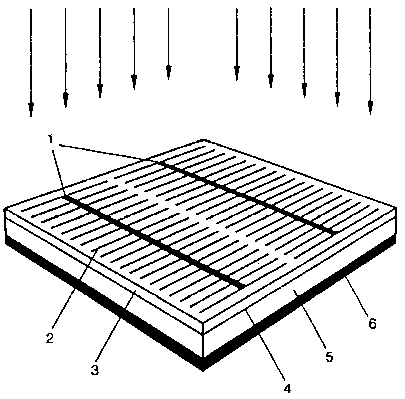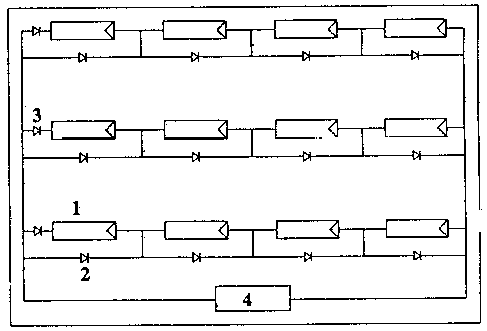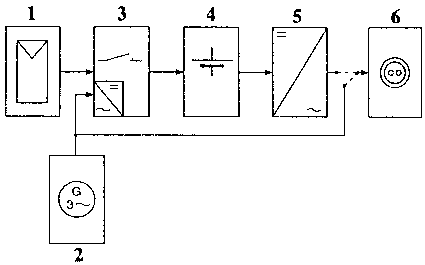



| Solar Energy |




| Solar Energy |
Photovoltaics
Ole Rahn, Viborgegnens Energy and Environment Office
Photovoltaic cells are used for producing electricity, where the previous mentioned solar technologies produce heat. Photovoltaics can be used for many purposes. But in grid-connected areas they are still not economically competitive.
Houses in remote areas can profitably use photovoltaics for lighting, cooling, communication, and TV. For pleasure boats (sailing boats) it is a big advantage to use photovoltaics for recharging batteries, and supply for instruments, navigation light, radio, light, and maybe refrigerator.
Photovoltaic cells are also used for operation of signalling lights for navigation and aviation. E.g. the light buoys that mark the submerged rocks, when entering through the Swedish skerries to Gothenburg, are equipped with reliable photovoltaic cells.
In the developing countries there are other purposes. The photovoltaics are used for operation of refrigerators for vaccine and medicine. Photovoltaic installations are often utilized for pumping drinking water and irrigation. The Photovoltaic cells are also used for operation of transportable dental clinics, smaller machines, plus for light, radio, and TV.
Many signal and communication installations are equipped with photovoltaic cells. At the South Indian railway from Madras to Cap Comorin many signal devices are driven by photovoltaic cells nowadays. In China, amplification stations for telephone connections in desert regions are equipped with photovoltaics.
History
The French physicist Alexandre Edmond Becquerel discovered in 1839 that some copper oxide electrons could produce electrical power, when they were lighted.
Charles Fritts, who produced the first photovoltaic cells from selenium in the 1988'es, predicted already then, that future buildings would be covered by photovoltaics for electricity production.
The first photovoltaic cell of silicon, which had an efficiency of appr. 6%, was produced by Fuller, Pearson and Chapin in 1954 at the Bell Laboratories in the USA.
In 1958 the first photovoltaics were sent out in space by the satellite Vanguard 1.
The development in space travel and research was the force behind the development that took place with photovoltaic technology in the 60'es and the 70'es. One of the most well-known installations from that time is the American Skylab, that was equipped with a photovoltaic plant with a nominal effect of appr. 20 kW.
The tremendous increase of energy price in the beginning of the 1970'es led to, that big amounts were invested in improving the photovoltaic technology. The development has gone through several generations, each with improved efficiency, increased life span, and lower production price. One of the significant conquests is the mass production of cheap amorphous (poly crystalline) silicon cells.
Today a large choice of products exists, that utilize photovoltaic processes for energy supply Pocket calculators, wrist watches, and signal devices for navigation and aviation, are just a few examples from our daily life.
Theory
A photovoltaic cell is a component that is able to convert radiation of light into electricity.
Photovoltaic cells arc made of a semiconductive material like selenium (Se), amorphous silicon (a-SiGe), crystalline silicon (Si), gallium arsenide (GaAs), copper/indium diselenide (CulnSe2) or cadmium telluride (CdTe). In bright weather the silicon cell produces appr. 0.5 Volt and appr. 25 mA per square centimetre surface, or in other words 17-13 mW/cmì.
Photovoltaic cells arc produced of semiconductors, in which a light sensitive area, a PN-junction is made near to the surface, where entering light is able to form positive areas. The charge of the PN-junction, which partly origins from grafted impurities, creates an electric potential. As there is a potential, and the entering light transfers energy to free electrons, then the photovoltaic cell can work as an electromotoric energy source - a generator.
The photovoltaic cell's sensitivity regarding specific wavelength's of light depends on, if the light is able to pass the surface of the cell, pass through the upper layer of the cell, and still have enough energy left to form a positive area in the PN-junction.
Types
Today various usable types of photovoltaic cells exist. Mono crystalline cells, poly crystalline, and amorphous cells.
Silicon is made from quarts (SiO2), which exists in large quantities in nature. The used silicon must be very pure, and for the production a lot of energy for heating is used. Also strong chlorine-containing compounds and bichloride are used. The pure silicon is doped (polluted), e.g. by boron, and thereafter various substances are steamed on.

1. Bus bar, 2. Metal grid, 3. Diffuse N-type layer, 4. NIP layer, 5. P-type doped base material, 6. P-type contact material.
Parts of the production processes are secret, as a costly development is taking place. The development is heading toward still thinner substrate cells, double function cells, and tandem cells. In the future we will also see granular photovoltaic cells with lower efficiency, but at a considerably lower price than todays photovoltaic cells.
Solar Radiation and Efficiency
The solar irradiation outside the Earth's atmosphere' the solar constant, is appr. 1350 W/mì. At the ground the solar intensity is about 1000 W/mì on a clear summer day in Denmark.
The efficiency is calculated as the percentage difference between the irradiated effect (Watt) per area unit, and the effect supplied from the photovoltaic cell.
There is a distinction between theoretical efficiency, laboratory efficiency, and practical efficiency. It is important to know the difference between these terms, and it is of course only the practical efficiency which is of interest to users of photovoltaics.
Silicon cells have a theoretical efficiency of appr. 28% and a practical efficiency of 14 to 16% (1992) By using other semi-conductive materials and other production methods, the efficiency can be increased.
The sunlight has its maximum relative intensity from 450 to 500 nanometre - in the blue light area. Therefore it is important to make the photovoltaic cell with maximum sensitivity close to that area. A photovoltaic cell looks bluish. It is because the blue light, that is containing most energy, is partly reflected from the cell. A typical silicon cell has its largest relative sensitivity in the area 700 to 900 nanometre - that is the infrared area. This missing coincidence is one of the reasons that photovoltaic cells do not have a specially high efficiency, and it is one of the areas being developed.
Another reason for the low efficiency is reflections from the cell surface. This can he met by anti reflective coatings, or by working out the cell surface as many small pyramidal structures.
The photovoltaic cell's efficiency decreases also with increasing temperatures, and they are damaged if the temperature exceeds 60 to 65 degrees.
The metal grid (bus bar and metal fingers) at the surface of the cell, which is used for collecting electrons' reduces the light sensitive area, and decreases thereby the efficiency of the cell.
Development
The main part of the development of photovoltaic technology takes place in the USA, Japan, and Germany. Especially in Japan enormous sums are invested in developing photovoltaic cells, and Japan has gained a great share of the market from USA during the latest years. In Germany remarkable results and high efficiency have been achieved by experiments in laboratories. In Denmark there is also one company working with development of photovoltaic cells.
One of the problems with the in general environmentally compatible photovoltaic cells is, that the consumption of strong chemicals connected to the production is high. They. believe they have solved this problem at the Danish photovoltaic cell factory Solel Energy now. The company has developed a strongly simplified and considerably more environmentally compatible production process, than the others known.
Applications
When designing a photovoltaic installation a lot of things must be taken into consideration, if an optimum solution is wanted.
At first it must be clarified, how much energy is demanded from the photovoltaic installation. After that the total daily consumption in Ampere hours (Ah) must be estimated. From the total daily and weekly consumption the total energy storage capacity can be calculated. It must be considered how many days the installation shall be capable of functioning without sun. At the end it can be calculated, how many photovoltaic modules are required to produce sufficient energy.
The tilt angle and orientation of the photovoltaic modules have big influence on the irradiated effect. In Northern Europe the optimum tilt angle is between 35 and 40 degrees, and the modules shall preferably be oriented towards south. A standard photovoltaic module like Siemens M 55 S has a maximum effect of 53 W by a voltage of appr. 13.8 V, and measures 1.3 m 0.32 m.
An installation for a summer cottage can for example be built of two 55 W photovoltaic modules, a regulator box, and a 100 Ah battery.
Such an installation can supply energy enough for lighting, TV, and a small refrigerator, during the summer months.
When more photovoltaic modules are combined in electrical series connection and parallel arrangements, it is important to mount by-pass diodes and string diodes. The diodes have to protect the photovoltaic cells against damaging fault currents, which can appear, when the modules are partly shadowed, or some modules are defect. The photovoltaic cells can not stand up to, that the current runs backwards under any operational condition, normal or not. Many photovoltaic modules are by the way mounted with by-pass diodes from the factory. String diodes must be mounted by one-self.

1. Photovoltaic modules, 2. By-pass diodes, 3. String diodes, 4. Consumer.
The photovoltaic application can be combined with other energy sources. A combination of small wind generators and photovoltaics is an obvious possibility. The energy can be stored in ordinary lead batteries, in nickel/cadmium batteries, in sodium/sulphur batteries, or by cracking water to hydrogen.
The author is developing computer software for calculation of photovoltaic installations. The software includes all variables that are important for the design of photovoltaic installations. The software can also calculate the average annual energy production from a certain installation.

1. Photovoltaic modules, 2. Wind generator, 3. Charging regulator, 4. Battery, 5. Inverter, 6. Consumers
Grid Connection
Abroad several large grid-connected photovoltaic power plants are erected. The technology is expensive. The photovoltaic cells produce direct current, which is stored in batteries. An electronic unit, an inverter, converts the direct current to three-phased alternating current by appr. 50 Hz. The inverter is regulated by the grid frequency, and it can be automatically synchronized, and connected to the grid. A Danish company, Sunelec, is developing a somewhat cheaper inverter for one-phased alternating current.
Life Span, Pollution
Photovoltaic cells produced today have a durability of at least 30 years. Photovoltaic cells can not be produced or scrapped without pollution, the used batteries can neither. These circumstances must be taken into consideration, when calling photovoltaic cells a supplier of non-polluting energy. Production processes, which harm the environment as little as possible, must be invented.
Future and Perspectives
The mono crystalline silicon cells are today the backbone of professional applications like communication and energy-supply in remote areas. The advantages are high efficiency (relative) and stable operation for many years. The disadvantage is a high price, as this type isn't suitable for mass production.
Thin-film cells and granular cells are the future. The advantage is lower price due to a continuous production. The disadvantages are, that these types are not ready yet, they are not stable yet, and their life span are still short.
The author thinks that within the next 20 years, we will see a large increase in the number of installed photovoltaic plants. Many grid-connected plants will be installed. In future installations the photovoltaics will be integrated in roof surfaces and outer walls.
Literature
Energi Nyt (Energy News), The Danish Energy Agency. 1992.
Forsog med solceller (Experiments with photovoltaics), Silkeborg SolData. 1991.
Electronic Design. May 1992.
Siemens Solar GmbH, Solarenergie. 1992.
Das Solarenergie Buch (The Solar Energy Book). 1992.

